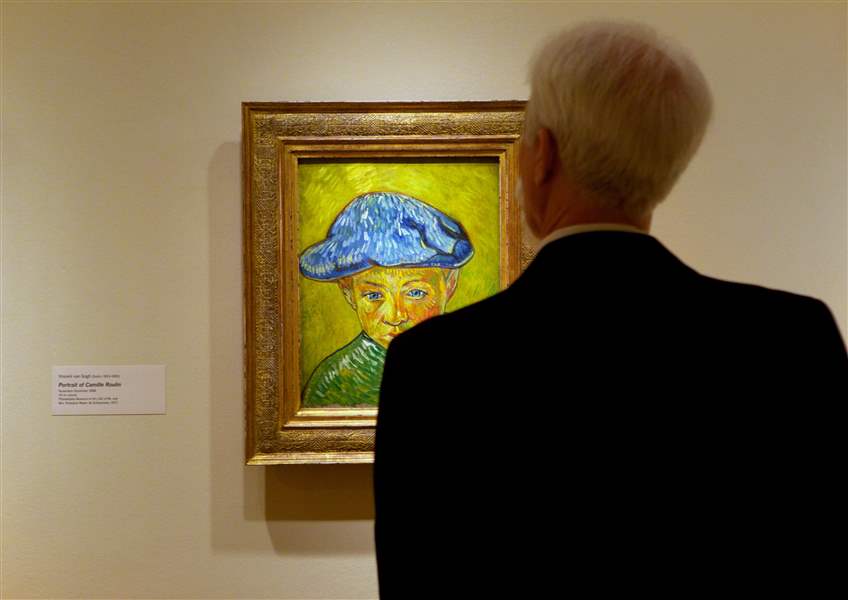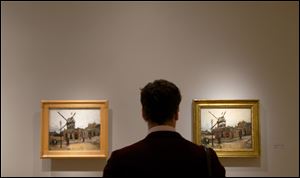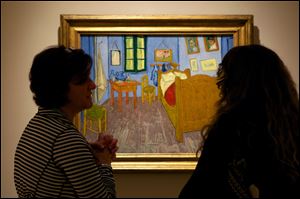
Van Gogh's artistic 'repetitions' featured in DC
10/11/2013
A visitor studies Vincent van Gogh's "Portrait of Camille Roulin," on display at The Phillips Collection in Washington. In the midst of the shutdown of federally funded museums, the private Phillips Collection is launching the first major exhibition of Vincent van Gogh’s artwork in Washington in 15 years. (AP Photo/Molly Riley)
ASSOCIATED PRESS

A visitor looks at Vincent van Gogh's "Le Moulin de la Galette," on display at The Phillips Collection in Washington.
WASHINGTON — Vincent van Gogh’s various versions of some of his well-known paintings are featured in the first major exhibit of his artwork in Washington in 15 years at The Phillips Collection.
“Van Gogh Repetitions” opens Saturday to examine some of the artist’s familiar paintings, looking at how he repeated certain compositions during his 10-year career. It was organized with the Cleveland Museum of Art, which will host the exhibit in March.
The new exhibit is a bright spot for museum visitors in the midst of a massive shutdown of Washington’s federally funded museums and attractions. It’s the result of an eight-year collaboration with curators in Cleveland and will be on view in Washington until Jan. 26.
Phillips Collection Director Dorothy Kosinski said much of van Gogh’s legacy and accomplishments are often distorted or forgotten.
“We think of his mental illness, we think of the anguish and rapidity of his working method,” Kosinski said. “And what this exhibition does in a very, very thoughtful way is to force us to look deeply — in a sense to perch on his shoulder in the studio, in the fields to follow his process — and to see how deliberate he was.”
It’s a project that is “both sexy and has brains,” she said, because it will draw visitors but also teach them how to look at pictures.
Curators brought together more than 30 paintings and works on paper, following van Gogh’s career in the Netherlands and in France.
They began with van Gogh’s 1889 paintings “The Large Plane Trees,” held by the Cleveland Museum of Art, and “The Road Menders,” which belongs to the Phillips. These are the first two versions of a composition van Gogh sought to perfect. They are usually displayed separately but now hang side by side, showing how van Gogh developed the scene’s trees, human figures and other details.

Women discuss Vincent van Gogh's "The Bedroom at Arles," on display at The Phillips Collection in Washington.
Another featured repetition includes van Gogh’s series of portraits of “The Postman Joseph Roulin” in Arles, France. Roulin was a friend and drinking companion to van Gogh. After Roulin’s third child was born, van Gogh remarked that his friend was “aglow,” and he wanted to paint a portrait of the proud father. He went on to make six paintings and three drawings of his friend.
The portraits have rarely, if ever, been shown together, curators said. They are usually displayed individually by museums in New York, Boston, Detroit, Philadelphia, Switzerland and the Netherlands.
During the period when he was painting the postman, van Gogh sliced off part of his ear in 1888 and was hospitalized. Roulin visited van Gogh in the hospital and took him on walks. One painting was likely intended as a gift for the loyal friend, curators said.
Van Gogh experimented with different colors and backgrounds as he painted his postman friend in uniform.
“Many artists repeat themselves. Many artists do a work on site and come back to the studio to revise it, refine it, strengthen the composition ... but we learn a great deal about van Gogh from looking at how he did this,” said curator Eliza Rathbone.
Van Gogh was interested in transforming his portrait into something more universal, she said. In his paintings, he used color to express harmonies and emotions in ways that give viewers of his work a “felt response,” Rathbone said.
“What we see really,” Rathbone said, “is an artist who is turning the corner into the 20th century and lays the groundwork for great artists like Matisse.”